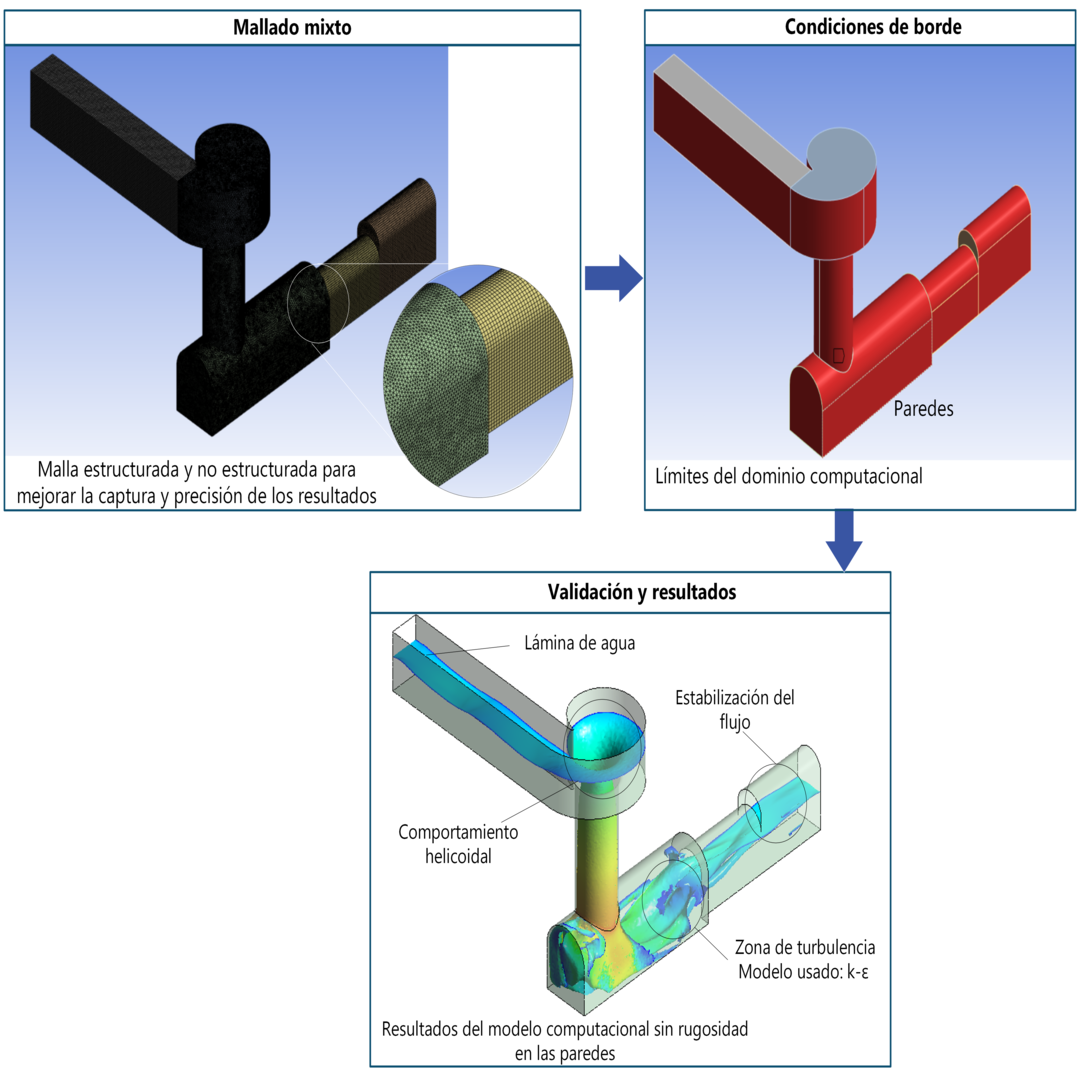Hydraulic Flow Behavior in the Numerical Model of a Vortex Energy Sink
##plugins.themes.bootstrap3.article.main##
Abstract
In order to analyze and understand the flow behavior in hydraulic structures, scale models are built; however, in the case of the vortex-type energy dissipator, the helical nature of the flow makes its analysis and data measurement difficult; therefore, a full-scale numerical model was built to allow a more efficient analysis of the flow in this type of dissipator. The computational fluid dynamics methodology was applied using the appropriate software. First, the heatsink geometry was created, then the meshing, after the boundary conditions and physical parameters were established, with which the model was solved, obtaining results that were validated with experimental data of the physical model, to finally analyze the prototype. The results obtained not only demonstrated the applicability of Computational Fluid Dynamics (CFD) in the hydraulic design and its calibration, but also provided a spatial distribution of the hydraulic characteristics along the prototype, an essential aspect in the design of this type of structures.
##plugins.themes.revistapolitecnica.stadistisDownloadTitle##
Downloads
Article Details
References
Ansys. (2023). ANSYS CFX [versión estudiantil para PC] (2023 R1).
Capote, J. A., Alvear, D., Abreu, O. V, Lázaro, M., & Espina, P. (2008). Influencia del modelo de turbulencia y del refinamiento de la discretización espacial en la exactitud de las simulaciones computacionales de incendios. Revista Internacional de Métodos Numéricos Para Cálculo y Diseño En Ingeniería, 24(3).
Chan, S. N., Qiao, Q. S., & Lee, J. H. W. (2018). On the three-dimensional flow of a stable tangential vortex intake. Journal of Hydro-Environment Research, 21(2018), 29-42. https://doi.org/10.1016/j.jher.2018.07.001
Chan, S. N., Qiao, Q. S., & Lee, J. H. W. (2019). Flow Features of an Unstable Tangential Vortex Intake. Green Energy and Technology. https://doi.org/10.1007/978-3-319-99867-1_55
Chiluisa C., & Guanoluisa C. (2015). Verificación del diseño hidráulico de un disipador de energía tipo vórtice mediante modelo físico construido en laboratorio. Universidad Central del Ecuador.
Crispino, G., Contestabile, P., Vicinanza, D., & Gisonni, C. (2021). Energy Head Dissipation and Flow Pressures in Vortex Drop Shafts. Water, 13(2), 165. https://doi.org/10.3390/w13020165
Del Giudice, G., Gisonni, C., & Rasulo, G. (2009). Vortex Drop Shaft for Supercritical Flow. In Advances in Water Resources and Hydraulic Engineering (pp. 1515–1520). Springer Berlin
Heidelberg. https://doi.org/10.1007/978-3-540-89465-0_262
Fernández J. (2011). Técnicas numéricas en ingeniería de fluidos (Editorial Reverté, Ed.; 1st ed.).
Hager, W. H. (1985). Head-Discharge Relation for Vortex Shaft. Journal of Hydraulic Engineering, 111(6). https://doi.org/10.1061/(asce)0733-9429(1985)111:6(1015)
Mrope, H. A., Chande Jande, Y. A., & Kivevele, T. T. (2021). A Review on Computational Fluid Dynamics Applications in the Design and Optimization of Crossflow Hydro Turbines. Journal of Renewable Energy, 2021, 1–13. https://doi.org/10.1155/2021/5570848
Ogunsesan, O. A., Hossain, M., & Droubi, M. G. (2021). Computational fluid dynamics modelling of multiphase flows in double elbow geometries. Proceedings of the Institution of Mechanical Engineers, Part E: Journal of Process Mechanical Engineering, 235(6), 1835–1846. https://doi.org/10.1177/09544089211021744
Rodal E., Echávez G., & Ruiz G. (2011). Estudio experimental en modelo hidráulico del pozo de alta caída. Instituto Argentino de Recursos Hídricos.
Rodríguez F. (2016). Modelación numérica del flujo en un descargador a vórtice aplicando mecánica de fluidos computacional (CFD). Escuela Politécnica Nacional.
Ruiz Solorio, G. (2014). MODELOS DE TURBULENCIA EN MECANICA DE FLUIDOS COMPUTACIONAL. XXII CONGRESO NACIONAL DE HIDRAULICA.
Sentyabov, A. V., Timoshevskiy, M. V., Pervunin, K. S., Gavrilov, A. A., Markovich, D. M., & Dekterev, A. A. (2016). Numerical and experimental investigation of cavitation flow around naca0015 hydrofoil. Bulletin of the Tomsk Polytechnic University, Geo Assets Engineering, 327(8).
SolidWorks. (2023). SolidWorks [versión estudiantil para PC] (2023).
Sotelo, G. (1974). Hidráulica General (Limusa, Ed.).
Usman, M., Shahid, S., Ali, S., & Ullah, M. K. (2023). Numerical simulations of turbulent and flow characteristics of complex river reach in Pakistan. Environmental Engineering Research, 28(1). https://doi.org/10.4491/eer.2021.369
Yang, Z., Yin, J., Lu, Y., Liu, Z., Yang, H., & Xu, G. (2021). Three-dimensional flow of a vortex drop shaft spillway with an elliptical tangential inlet. Water (Switzerland), 13(4). https://doi.org/10.3390/w13040504
Zhang, W., Wang, J., Zhou, C., Dong, Z., & Zhou, Z. (2018). Numerical simulation of hydraulic characteristics in a vortex drop shaft. Water (Switzerland), 10(10). https://doi.org/10.3390/w10101393
Zhao, C.-H., Zhu, D. Z., Sun, S.-K., & Liu, Z.-P. (2006). Experimental Study of Flow in a Vortex Drop Shaft. Journal of Hydraulic Engineering, 132(1). https://doi.org/10.1061/(asce)0733-9429(2006)132:1(61)




